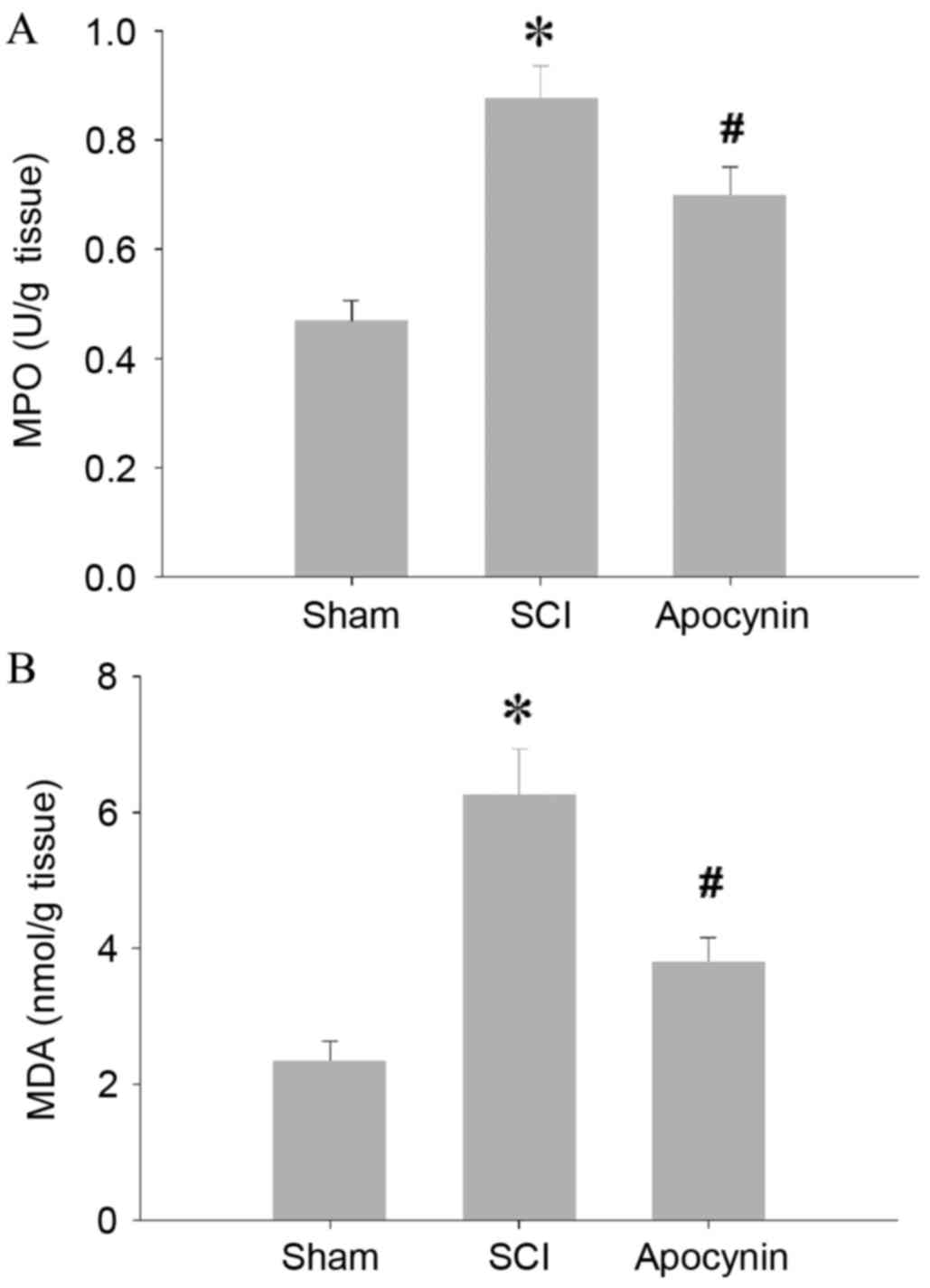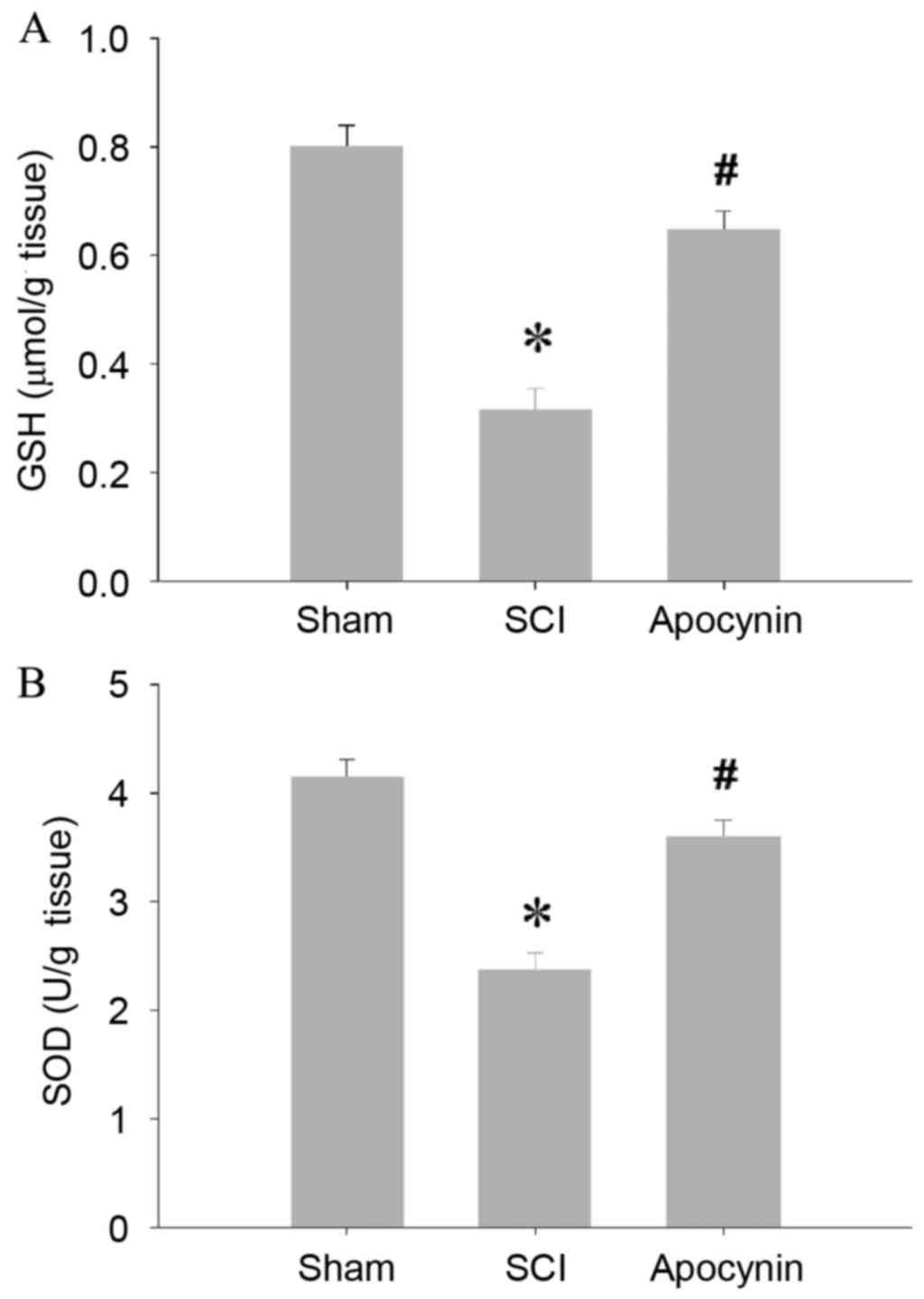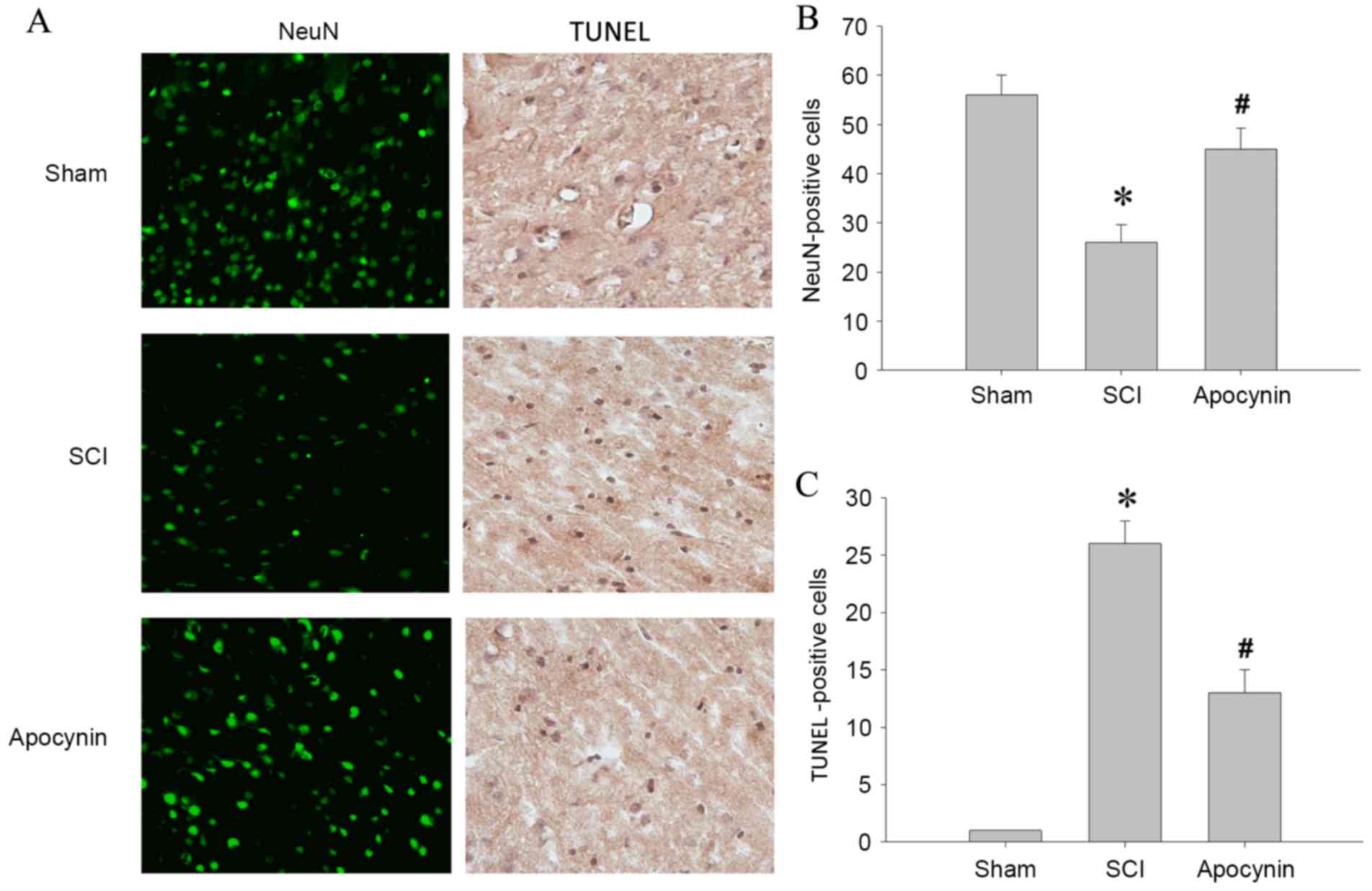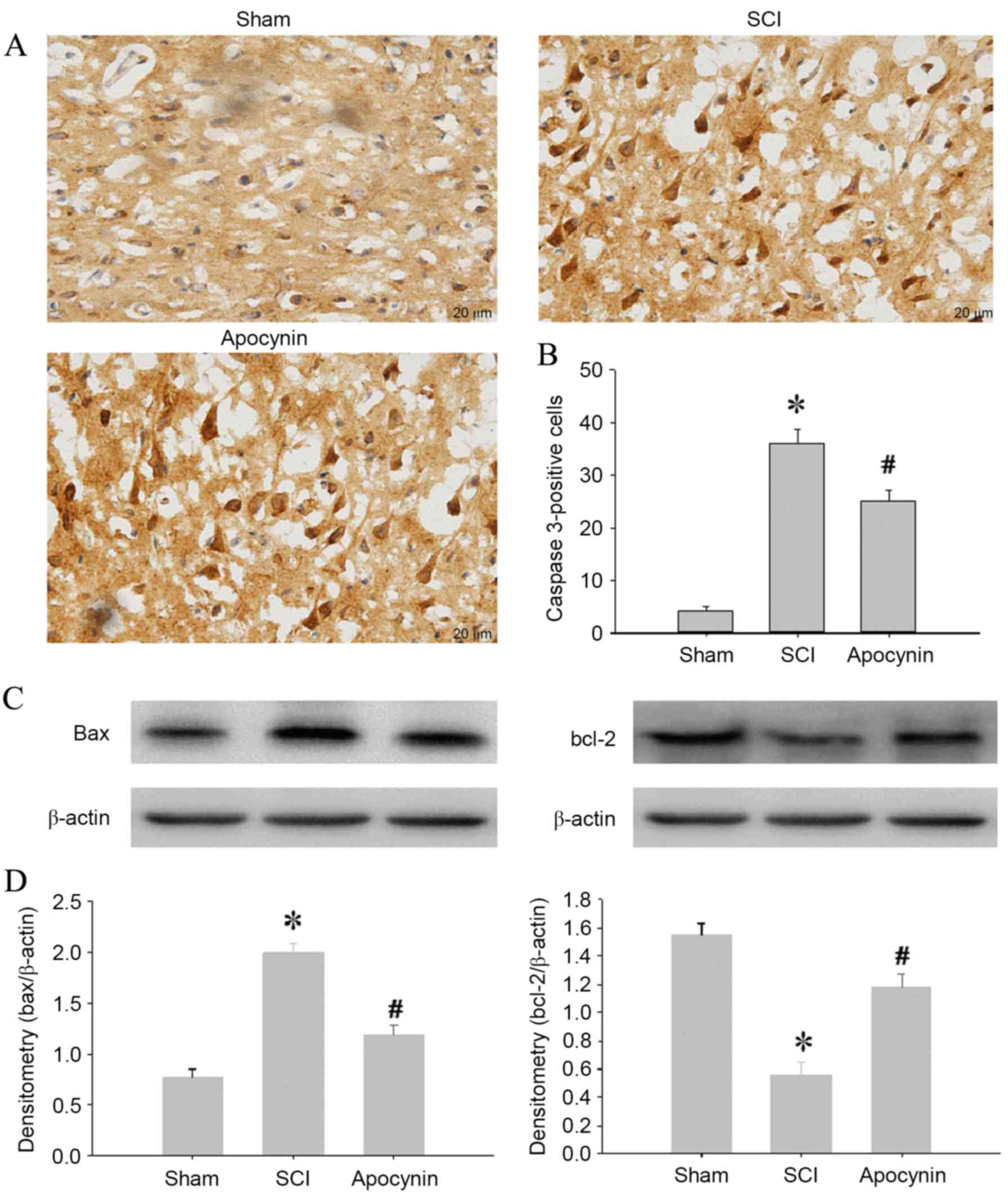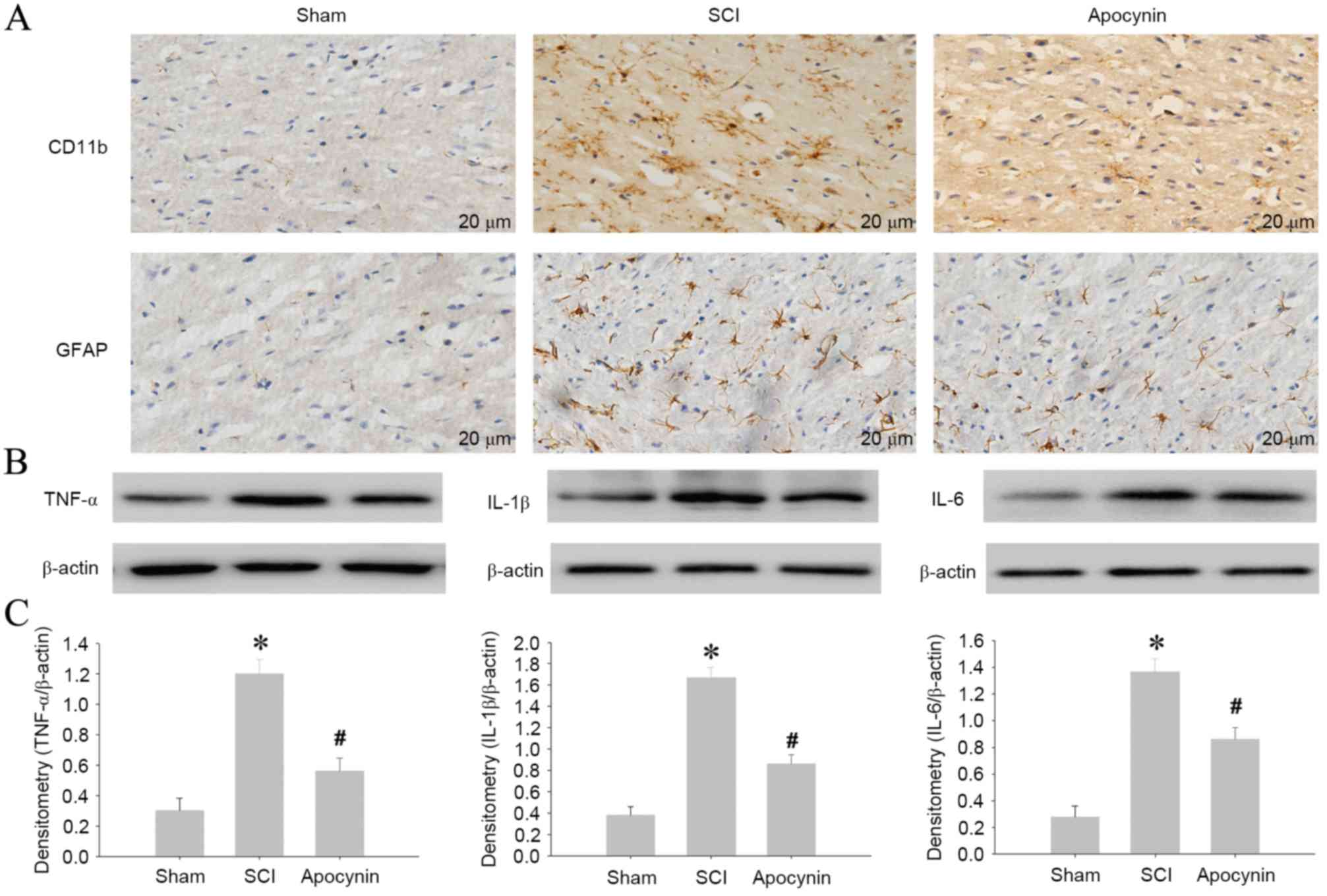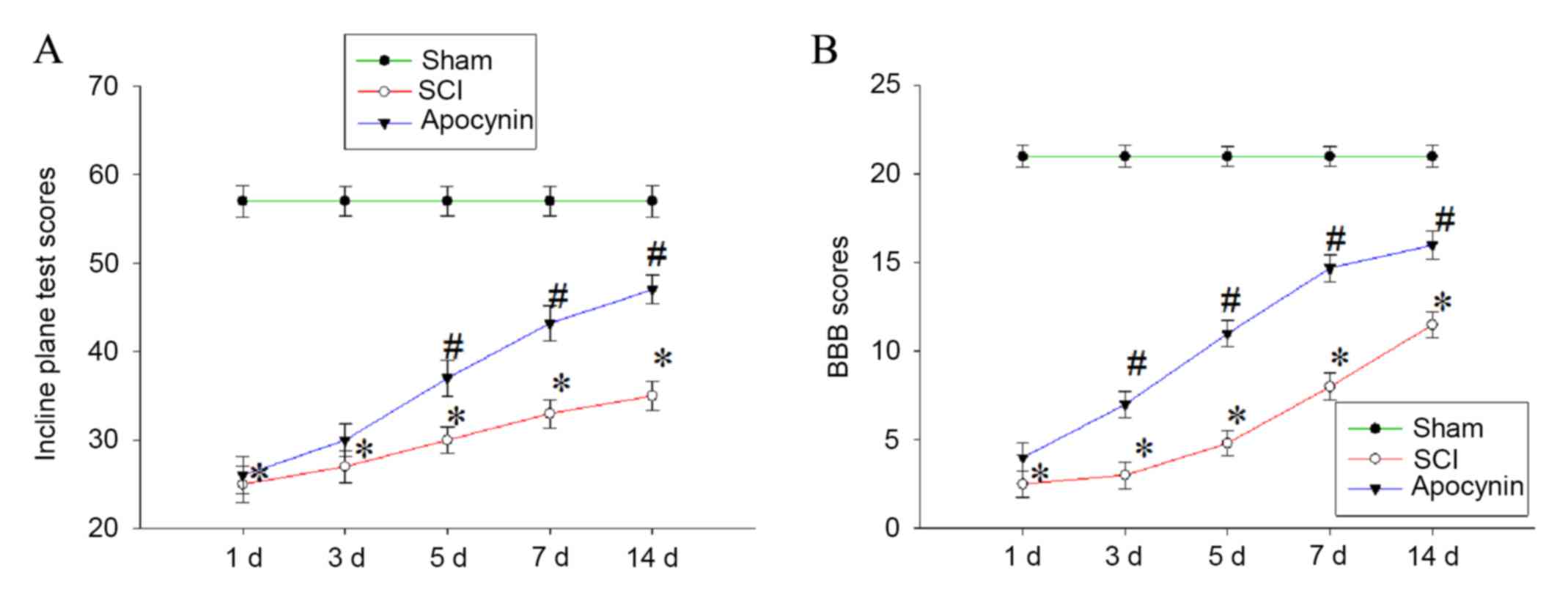|
1
|
Grigorean VT, Sandu AM, Popescu M,
Iacobini MA, Stoian R, Neascu C, Strambu V and Popa F: Cardiac
dysfunctions following spinal cord injury. J Med Life. 2:133–145.
2009.PubMed/NCBI
|
|
2
|
Kwon BK, Tetzlaff W, Grauer JN, Beiner J
and Vaccaro AR: Pathophysiology and pharmacologic treatment of
acute spinal cord injury. Spine J. 4:451–464. 2004. View Article : Google Scholar : PubMed/NCBI
|
|
3
|
Liu D, Xu GY, Pan E and McAdoo DJ:
Neurotoxicity of glutamate at the concentration released upon
spinal cord injury. Neuroscience. 93:1383–1389. 1999. View Article : Google Scholar : PubMed/NCBI
|
|
4
|
Hausmann ON: Post-traumatic inflammation
following spinal cord injury. Spinal Cord. 41:369–378. 2003.
View Article : Google Scholar : PubMed/NCBI
|
|
5
|
Walker CL, Walker MJ, Liu NK, Risberg EC,
Gao X, Chen J and Xu XM: Systemic bisperoxovanadium activates
Akt/mTOR, reduces autophagy and enhances recovery following
cervical spinal cord injury. PLoS One. 7:e300122012. View Article : Google Scholar : PubMed/NCBI
|
|
6
|
Lu J, Ashwell KW and Waite P: Advances in
secondary spinal cord injury: Role of apoptosis. Spine (Phila Pa
1976). 25:1859–1866. 2000. View Article : Google Scholar : PubMed/NCBI
|
|
7
|
Xiong Y, Rabchevsky AG and Hall ED: Role
of peroxynitrite in secondary oxidative damage after spinal cord
injury. J Neurochem. 100:639–649. 2007. View Article : Google Scholar : PubMed/NCBI
|
|
8
|
Khayrullina G, Bermudez S and Byrnes KR:
Inhibition of NOX2 reduces locomotor impairment, inflammation, and
oxidative stress after spinal cord injury. J Neuroinflammation.
12:1722015. View Article : Google Scholar : PubMed/NCBI
|
|
9
|
Bedard K and Krause KH: The NOX family of
ROS-generating NADPH oxidases: Physiology and pathophysiology.
Physiol Rev. 87:245–313. 2007. View Article : Google Scholar : PubMed/NCBI
|
|
10
|
Lo W, Bravo T, Jadhav V, Titova E, Zhang
JH and Tang J: NADPH oxidase inhibition improves neurological
outcomes in surgically-induced brain injury. Neurosci Lett.
414:228–232. 2007. View Article : Google Scholar : PubMed/NCBI
|
|
11
|
White CN, Figtree GA, Liu CC, Garcia A,
Hamilton EJ, Chia KK and Rasmussen HH: Angiotensin II inhibits the
Na+-K+ pump via PKC-dependent activation of NADPH oxidase. Am J
Physiol Cell Physiol. 296:C693–C700. 2009. View Article : Google Scholar : PubMed/NCBI
|
|
12
|
Choi BY, Jang BG, Kim JH, Lee BE, Sohn M,
Song HK and Suh SW: Prevention of traumatic brain injury-induced
neuronal death by inhibition of NADPH oxidase activation. Brain
Res. 1481:49–58. 2012. View Article : Google Scholar : PubMed/NCBI
|
|
13
|
Chen H, Song YS and Chan PH: Inhibition of
NADPH oxidase is neuroprotective after ischemia-reperfusion. J
Cereb Blood Flow Metab. 7:1262–1272. 2009. View Article : Google Scholar
|
|
14
|
Impellizzeri D, Mazzon E, Esposito E,
Paterniti I, Bramanti P and Cuzzocrea S: Effect of Apocynin, an
inhibitor of NADPH oxidase, in the inflammatory process induced by
an experimental model of spinal cord injury. Free Radic Res.
45:221–236. 2011. View Article : Google Scholar : PubMed/NCBI
|
|
15
|
Rivlin A and Tator CH: Effect of duration
of acute spinal cord compression in a new acute injury model in the
rat. Surg Neurol. 10:38–43. 1978.PubMed/NCBI
|
|
16
|
Hillegass LM, Griswold DE, Brickson B and
Albrightson- Winslow C: Assessment of myeloperoxidase activity in
whole rat kidney. J Pharmacol Methods. 24:285–295. 1990. View Article : Google Scholar : PubMed/NCBI
|
|
17
|
Beuge JA and Aust SD: Microsomal lipid
peroxidation. Methods Enzymol. 52:302–310. 1978. View Article : Google Scholar : PubMed/NCBI
|
|
18
|
Oyanagui Y: Revaluation of assay methods
and establishment of kit for superoxide dismutase activity. Anal
Biochem. 142:290–296. 1984. View Article : Google Scholar : PubMed/NCBI
|
|
19
|
Zhou C, Tu J, Zhang Q, Lu D, Zhu Y, Zhang
W, Yang F, Brann DW and Wang R: Delayed ischemic postconditioning
protects hippocampal CA1 neurons by preserving mitochondrial
integrity via Akt/GSK3β signaling. Neurochem Int. 59:749–758. 2011.
View Article : Google Scholar : PubMed/NCBI
|
|
20
|
Donnelly DJ, Gensel JC, Ankeny DP, van
Rooijen N and Popovich PG: An efficient and reproducible method for
quantifying macrophages in different experimental models of central
nervous system pathology. J Neurosci Methods. 181:36–44. 2009.
View Article : Google Scholar : PubMed/NCBI
|
|
21
|
Rivlin AS and Tator CH: Objective clinical
assessment of motor function after experimental spinal cord injury
in the rat. J Neurosurg. 47:577–581. 1977. View Article : Google Scholar : PubMed/NCBI
|
|
22
|
Basso DM, Beattie MS and Bresnahan JC: A
sensitive and reliable locomotor rating scale for open field
testing in rats. J Neurotrauma. 12:1–21. 1995. View Article : Google Scholar : PubMed/NCBI
|
|
23
|
Blight AR: Morphometric analysis of blood
vessels in chronic experimental spinal cord injury:
Hypervascularity and recovery of function. J Neurol Sci. 2:158–174.
1991. View Article : Google Scholar
|
|
24
|
Song Y, Liu J, Zhang F, Zhang J, Shi T and
Zeng Z: Antioxidant effect of quercetin against acute spinal cord
injury in rats and its correlation with the p38MAPK/iNOS signaling
pathway. Life Sci. 92:1215–1221. 2013. View Article : Google Scholar : PubMed/NCBI
|
|
25
|
Juurlink BH and Paterson PG: Review of
oxidative stress in brain and spinal cord injury: Suggestions for
pharmacological and nutritional management strategies. J Spinal
Cord Med. 21:309–334. 1998. View Article : Google Scholar : PubMed/NCBI
|
|
26
|
Hernandes MS, D'Avila JC, Trevelin SC,
Reis PA, Kinjo ER, Lopes LR, Castro-Faria-Neto HC, Cunha FQ, Britto
LR and Bozza FA: The role of Nox2-derived ROS in the development of
cognitive impairment after sepsis. J Neuroinflammation. 11:362014.
View Article : Google Scholar : PubMed/NCBI
|
|
27
|
Keirstead HS, Nistor G, Bernal G, Totoiu
M, Cloutier F, Sharp K and Steward O: Human embryonic stem
cell-derived oligodendrocyte progenitor cell transplants
remyelinate and restore locomotion after spinal cord injury. J
Neurosci. 19:4694–4705. 2005. View Article : Google Scholar
|
|
28
|
Zhang Z, Huang Z, Dai H, Wei L, Sun S and
Gao F: Comparison of methylprednisolone and calpain inhibitor for
the protection of ischemiareperfusion spinal cord injury in rats.
Ortho J Chin. 19:1026–1029. 2011.
|
|
29
|
Fehlings MG and Nguyen DH: Immunoglobulin
G: A potential treatment to attenuate neuroinflammation following
spinal cord injury. J Clin Immunol. 30:(Suppl 1). S109–S112. 2010.
View Article : Google Scholar : PubMed/NCBI
|
|
30
|
Faulkner JR, Herrmann JE, Woo MJ, Tansey
KE, Doan NB and Sofroniew MV: Reactive astrocytes protect tissue
and preserve function after spinal cord injury. J Neurosci.
24:2143–2155. 2004. View Article : Google Scholar : PubMed/NCBI
|
|
31
|
Impellizzeri D, Esposito E, Mazzon E,
Paterniti I, Di Paola R, Bramanti P, Morittu VM, Procopio A, Perri
E, Britti D and Cuzzocrea S: The effects of a polyphenol present in
olive oil, oleuropein aglycone, in an experimental model of spinal
cord injury in mice. Biochem Pharmacol. 83:1413–1426. 2012.
View Article : Google Scholar : PubMed/NCBI
|
|
32
|
Rong W, Wang J, Liu X, Jiang L, Wei F, Hu
X, Han X and Liu Z: Naringin treatment improves functional recovery
by increasing BDNF and VEGF expression, inhibiting neuronal
apoptosis after spinal cord injury. Neurochem Res. 37:1615–1623.
2012. View Article : Google Scholar : PubMed/NCBI
|
|
33
|
Wei H, Teng H, Huan W, Zhang S, Fu H, Chen
F, Wang J, Wu C and Zhao J: An upregulation of SENP3 after spinal
cord injury: Implications for neuronal apoptosis. Neurochem Res.
37:2758–2766. 2012. View Article : Google Scholar : PubMed/NCBI
|
|
34
|
Dlugosz PJ, Billen LP, Annis MG, Zhu W,
Zhang Z, Lin J, Leber B and Andrews DW: Bcl-2 changes conformation
to inhibit Bax oligomerization. EMBO J. 25:2287–2296. 2006.
View Article : Google Scholar : PubMed/NCBI
|















